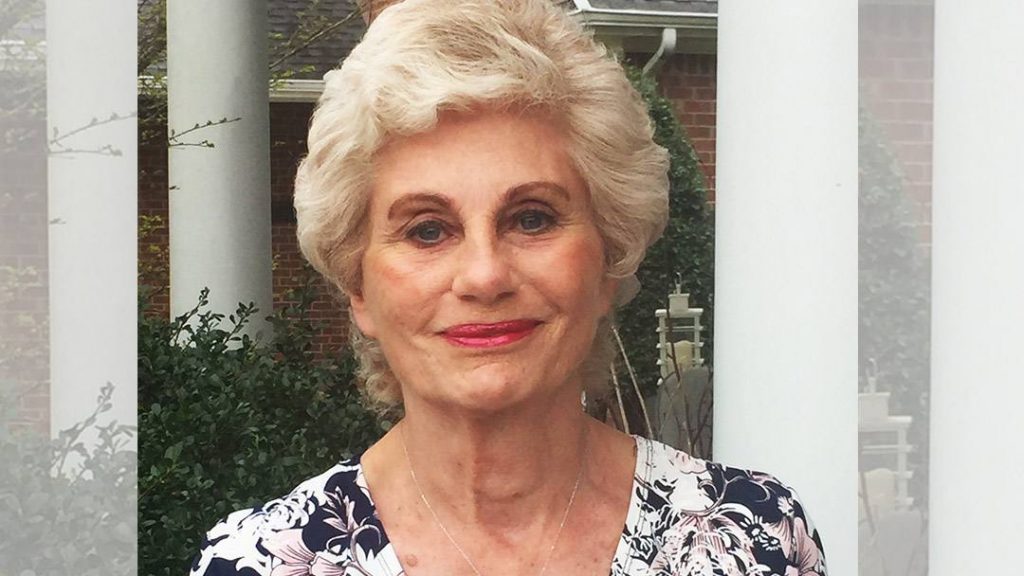
When Jean Niven learned she had ovarian cancer, her desire to find a knowledgeable, compassionate physician led her to Mayo Clinic. Then, when her cancer returned, genetic information opened the door to fresh treatment options.
Gathering all the necessary information about a decision prior to making it has always helped attorney Jean Niven in the courtroom. Nowhere, however, has this habit been more useful to Jean than the hospital room.
When Jean was diagnosed with ovarian cancer in 2018, she relied on research to guide her to Mayo Clinic. There her medical team supplied her with information, explanations and honesty about her treatment plan.
Jean's treatment involved two-part chemotherapy and surgery, as well as genetic testing. The results of that testing paved the way for Jean to received targeted therapy against her BRCA1-positive cancer.
"I do research, and I think it's important for an individual to be an active participant in their care," says Jean, who lives near Pensacola, Florida.
The information Jean received from her team at Mayo Clinic's Florida campus, including medical oncologist Gerardo Colon-Otero, M.D., in the Division of Hematology/Oncology and gynecological surgeon Tri Dinh, M.D., in the Department of Obstetrics and Gynecology, reassured her she was getting the best care.
"They always have answered every one of my questions to the best of their abilities," Jean says. "If they didn't have the answer, they were forthright in letting me know. I was given first-rate medical advice and care, not just pacified. I never felt like I was just a number or rushed through the appointment."
A history of cancer
Jean is no stranger to medical treatment. On New Year's Eve 1996, when she was in her late 40s, she was diagnosed with breast cancer. Two weeks after her diagnosis, she underwent a lumpectomy to remove the tumor. Jean also received radiation therapy to treat any residual microscopic cells. At her six-month follow-up appointment, imaging came back negative for cancer cells. Her next scan was negative, as was the following.
For more than 20 years, Jean's scans showed no signs of cancer. During this time, Jean, who has four adult children and several grandchildren, enjoyed good health. She ate a balanced diet, refrained from drinking alcohol, exercised and enjoyed a full travel schedule. But in December 2017, just before a vacation to Europe, Jean began experiencing abdominal pain and bloating. She sought medical advice from her regular care team but received no definitive answers.
Jean was exhausted throughout her vacation, she says. "I pushed myself to do everything I possibly could, but I didn't have the energy to do everything I wanted."
Jean returned from that trip only to take off on another — this time to watch the humpback whale migration off the coast of Hawaii's Big Island. "I had my itinerary all planned, so I pushed myself to do everything I could, but I really wasn't feeling well," she says. "I was having a lot of abdominal discomfort, and I didn't know why."
Back home, Jean turned to her physician for answers. She received a bilateral mammogram and chest MRI with contrast dye. The MRI came back as abnormal, which led Jean's oncologist to order a pelvic and abdominal CT scan. The scan revealed tumors on her ovaries and uterus. Jean was connected to a specialist to discuss a treatment plan, but the encounter did not go well.
"When he was explaining things to me, I had some questions regarding the toxicity of the platinum-based chemotherapy drugs," Jean says. "I wanted to know the potential effects of the drugs on the kidneys, and he just looked at me and said my hair would grow back. I felt very demeaned."
Jean relayed the episode to her former husband, who lives in Jacksonville, Florida. "He was touting the benefits of Mayo Clinic and was doing some research and said, 'Please, make an appointment.' So I said, 'OK.'"
A two-pronged treatment plan
Jean called Mayo Clinic's Florida campus and arranged an appointment. In early April, she made the first of many five-hour drives to Mayo Clinic to see Dr. Colon-Otero.
"I knew I was in very good medical hands," Jean says. "I had very specific questions, and he was very willing to explain things to me. I wanted to know why other kinds of therapy were not considered to be an option for me, and he took the time to explain it. I felt comfortable that I was making the right choice."
In addition to seeing Dr. Colon-Otero, who recommended Jean begin chemotherapy immediately, Jean was evaluated by Dr. Dinh.
"The treatment of ovarian cancer is typically surgery and chemotherapy," Dr. Dinh says. "When I trained as a fellow in the early 2000s, and up until 2010, the thought was that we should always operate on people first to remove everything we can and then give them chemotherapy."
"I knew I was in very good medical hands. I had very specific questions, and (Dr. Colon-Otero) was very willing to explain things to me."
Jean Niven
But a 2010 research study reported patients with advanced ovarian cancer, such as Jean's, recover more quickly from surgery with the administration of neoadjuvant chemotherapy — chemotherapy that's given before and after surgery.
"If you've already been sick, with surgery, you get sicker," Dr. Dinh says. "With the neoadjuvant approach, you give patients chemotherapy, and you shrink the disease. If you get them better from the chemotherapy, they actually get healthier. They improve their diet and nutrition, and so you can do a better surgery. As the cancer gets smaller, it's an easier surgery."
Jean received her first round of chemotherapy the day after her meeting with Dr. Colon-Otero. Although she experienced severe side effects that required hospitalization, the medication reduced her cancer markers by hundreds of points.
"I was told that if it came down 100 points, they would be ecstatic," Jean says. "Fifty points would be in the realm of 'it's working' and more in the range of their expectations. When I went back and had the blood work done, it had actually come down almost 500 points. I was very pleased, as were they."
Genetic testing, encouraging results
By the time Jean had her surgery in June 2018, her tumor markers were down by more than 1,000 points, and only a fraction of the diseased tissue remained. Jean recovered quickly from surgery, which involved removing her ovaries, fallopian tubes, uterus and cancerous tumors. After three days, she was discharged from the hospital, and her son drove her home to Pensacola.
Over the next two months, Jean received her remaining chemotherapy infusions, which were administered intravenously over a five-hour period at Mayo Clinic. During each visit, Jean met with her medical team and learned her tumor markers continued to decrease. Within two weeks of completing her final chemotherapy infusion in August 2018, Jean was back to work.
"When I went in three months after the treatment, they did the CT scan, and that was fine," Jean says. "There were no issues there, and the cancer markers were at 9. When I went back the last time on Feb. 27, that's when they saw the issue."
"Because medicine has expanded so much, it's critical to have a team of experts who specialize in different areas caring for patients."
Gerardo Colon-Otero, M.D.
Jean's cancer markers increased to 115, and a CT scan revealed two small growths. The growth of Jean's cancer so soon after receiving the most effective chemotherapy against her disease was concerning, Dr. Dinh says. "When you give the best chemo and have a recurrence right after that, it doesn't bode well for your second line of chemo."
When Jean's cancer came back, Drs. Dinh and Colon-Otero brought her case before Mayo Clinic's tumor board — a multidisciplinary body comprised of radiation oncologists, gynecologic oncologists, medical oncologists, radiologists and pathologists.
"Because medicine has expanded so much, it's critical to have a team of experts who specialize in different areas caring for patients," Dr. Colon-Otero says.
Alternate, individualized therapy
While the tumor board did not recommend further surgery, an alternate treatment option was available for Jean. Genetic testing she'd received came back positive for the BRCA1 gene.
"That just opened up a whole world of medications called PARP inhibitors," Dr. Dinh says.
In the body, an enzyme known as the PARP protein helps repair damaged DNA in cancer cells, allowing them to divide. PARP inhibitors work by blocking the protein from functioning, leaving the damaged cells to die. "What we know of PARP inhibitors is that the response rate is quite good," Dr. Dinh says.
"What sets Mayo Clinic apart is not just their competency, but their willingness to treat you as an individual and engage you as a patient."
Jean Niven
In early April, Jean started on the daily, oral medication. She will continue taking the medication until it's no longer effective or something better becomes available to treat her condition. Jean will be monitored with regular blood tests and imaging, the results of which will help her team make decisions about the path forward. In the meantime, Jean's working full time and enjoying time with her family.
Throughout her treatment journey, Jean has found the attention and honesty she's received from her Mayo Clinic care team to be encouraging and empowering.
"There are a lot of wonderful doctors. What sets Mayo Clinic apart is not just their competency, but their willingness to treat you as an individual and engage you as a patient," Jean says. "You feel that dynamic. It gave me an optimism about my treatment because I felt fully informed, and I felt like I was a partner in making these choices. And that to me was incredibly important."
HELPFUL LINKS
- Learn more ovarian cancer care at Mayo Clinic.
- Check out the Mayo Clinic Cancer Center.
- Connect with others talking about gynecologic cancers and breast cancer on Mayo Clinic Connect.
- Explore Mayo Clinic.
- Request an appointment.







